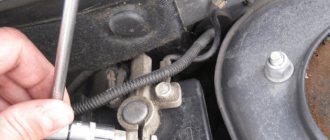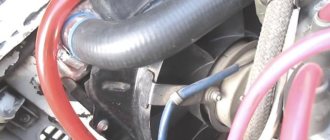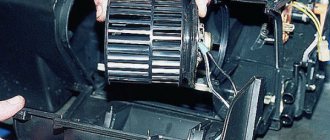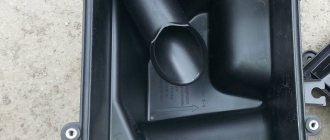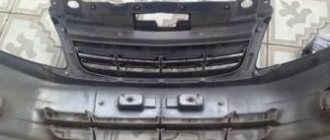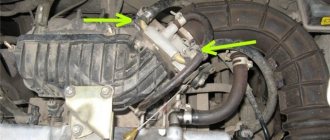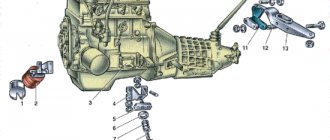Starting a car engine in winter is half the battle, but keeping the cabin warm is a more difficult question. If in your car the process of warming up the interior takes a long time, then you can install a coolant heater in the system. This operation is quite expensive, which is why it is not very popular.
If you don’t know how you can retain heat in the cooling system longer, then we will tell you about such an interesting method - “radiator insulation”. There are many myths around this method, and no one has tested the benefits of the method experimentally. That is why in this article we will look at why you need to insulate a radiator, as well as how to do it correctly.
Is it necessary to close the radiator grille in winter?
Those people who are ardent opponents of all cardboard and other insulation materials believe that if the regulator in the car works properly, then there is no need to wrap the radiator. And indeed, this is so, because the liquid circulates in a small circle, completely bypassing the radiator, which is why there is no need for insulation. But if the movement of the coolant is transferred to a large circle, then there is a need to insulate the radiator grille.
The fact is that only by insulating the radiator will it be possible to maintain a stable operating temperature of the engine. And this, in turn, will have a beneficial effect on the operation of the engine, because it will wear out significantly less.
Attention!
It is necessary to insulate the radiator when the air temperature outside reaches -10º C - not earlier!
Why is the radiator closed on old cars?
The tradition of closing the car radiator for the winter appeared quite a long time ago. To understand the need for such a procedure, you need to remember the mechanism of operation of the radiator on machines that appeared on the market in the late 80s and earlier. In such cars, the radiator was cooled by a fan due to a belt drive from the crankshaft, which spun the fan. Accordingly, the higher the car's speed, the faster the fan rotated and the radiator received more cooling.
The disadvantages of such a cooling system were obvious - the inability to control the operation of the fan at different ambient temperatures. In other words, even in cold winter, when the car was moving at high speed, the fan was spinning strongly. Because of this, problems arose in the operation of the engine. The engine did not warm up to the required operating temperatures, which could cause various malfunctions. In summer, such cooling was also not effective. At high speed, the engine managed to cool down, but at idle it often overheated, since the high ambient temperature and low fan speed did not have time to reduce its temperature to operating temperature.
Based on the above, it becomes clear that in winter it was necessary to limit the cooling of the radiator by counter-flow of air, especially in severe frost. To do this, cardboard boxes were installed that did not allow air to pass through, and the radiator was cooled only by a fan when the car was moving.
Theoretical knowledge
It is better to learn how to properly install insulation from experienced drivers who have been driving for several years. There is nothing difficult in this operation, but still, the advice of experienced craftsmen will definitely not be superfluous. You should be interested in why this is necessary at all only after mastering this insulation technology. Making the right decision and the chosen insulation method makes it possible to evaluate all the advantages and benefits of engine insulation.
If you restrict the air flow to the grille, you will receive the following benefits:
- When driving at high speeds, heat will remain in the engine compartment.
- The desired coolant temperature is quickly reached, the engine quickly reaches a sufficient temperature, and this will warm up the air in the car’s interior faster.
- Even when driving short distances, the engine will warm up faster.
Disadvantages of radiator insulation
- Risk of engine overheating and costly repairs.
- Does not make cold starting easier after a long period of parking.
- Does not affect battery life.
So, should you cover the grille on a modern car? You can do this, or you can not, there will be no mistake. It is necessary to take into account the air temperature in your region. If stable subzero temperatures of -15 and below prevail, then it is better to close.
This manipulation will help protect the engine from excessive wear. If you live in a mild climate with European winters, then this does not make much sense, but there is a risk of engine overheating.
Practical significance
Premium cars are equipped with special dampers; they make it possible to regulate the flow of air that will blow over the engine. If the engine reaches a constant operating temperature in a short time, the condition of the engine elements will be maintained in good condition. That is why there are so many ways to close the radiator, because it is really worth it, as it reduces engine wear.
Car radiator insulation
If the air circulates under the hood on its own, then this will only be a plus, and here’s why:
- Fuel consumption will be significantly reduced, and the thing is that when the engine is cold, the electronic control unit directs a supersaturated fuel mixture into the cylinders.
- Once the additional air flow through the radiator grille stops, the engine will warm up faster and the air in the cabin will also warm up faster. Basically, many motorists insulate the radiator for this very reason, so the air in the cabin will warm up several times faster.
You can especially notice changes when the temperature outside drops below 20-25 degrees Celsius. In this case, the climate in the cabin will become favorable in a short time, and at idle speed. This is confirmed by owners of both carburetor and injection cars.
Homemade radiator insulation on a car
Sometimes owners simply purchase an additional heater that will be powered from the cigarette lighter. But another part of motorists does not see the point in additional expenses, because they can simply insulate the radiator.
Car heater inside the cabin
Modernization and improvement of the stove
While processing the interior, you should immediately check the functionality of the heating system. On the VAZ-2107, the heater design has some design flaws. In addition, over time, the seals of the housing and air ducts cease to perform their function, which leads to the dissipation of the flow of warm air.
The main design flaw in the VAZ-2107 is insufficient fan characteristics (power, number of revolutions). To eliminate this drawback, you can replace the standard electric motor with an electric one. the motor is from a VAZ-2108, but for this you will have to slightly modify the fan housing. But we note that in addition to the motor, you need to immediately change the fuse and rheostat.
A more significant modification is the installation of a VAZ-2108 fan into the stove along with the housing (“Snail”). Such an upgrade will not only provide a powerful air flow, but will also operate more quietly.
When working with the stove, it is worth disassembling the air ducts, cleaning them thoroughly, and putting the structure back together, installing new seals. Additionally, the joints can be covered with insulating materials (the same vibration isolator) to eliminate the possibility of air leakage. The same should be done with the stove body.
If the heat exchanger of the stove warms up poorly, it may require flushing or replacement. The pipes in the interior radiator have a small cross-section, so over time they become clogged with dirt, which greatly reduces heat transfer.
If the radiator is very dirty, it is difficult to wash the dirt out of it, so in such cases it is easier to buy a new one.
Myths about insulating the radiator grille
Many companies try so hard to promote their radiator insulation products that they come up with non-existent benefits from insulation or elevate this benefit to an absolute, greatly exaggerating it. Such tricks often work, and car owners buy such products without hesitation.
Car blanket insulation
We decided to tell you about certain myths, so that in the future you can think about and evaluate whether insulation is really such a benefit, and whether you specifically need it. Here are a few arguments that manufacturers use:
- Fuel savings up to 30%.
- The battery will hold its charge much longer.
- Makes it easier to start the engine when the engine is cold.
As you might have guessed, some criteria are greatly exaggerated, and insulation has virtually no effect on the ease of starting, because during a frosty night the internal combustion engine still manages to freeze very much - even the most heat-retaining material will not be able to retain heat in winter for more than 5-6 hours. The insulation doesn’t really help the battery either, because the crankshaft still has to be turned in thick oil. That is why we urge you not to fall for such tricks and to sensibly evaluate the advantages and disadvantages of such products.
Insulated engine and radiator grille
Thus, radiator insulation helps and facilitates some aspects of the car’s operation, but is not a panacea. It will help save fuel, the engine will warm up faster in the cold, the car will become warmer, but this does not mean that the internal systems of the car will be maintained at room temperature around the clock.
And yet: is it necessary to close the car radiator in winter and the relevance of the “cardboard”
Theoretical effect
It is better to learn how to properly close the radiator for the winter from experienced drivers. There’s nothing complicated about it, but some extra advice won’t hurt. Be interested in what and how, preferably after mastering it, why it is needed and getting an answer to the question whether this method of insulation actually helps. Making a final decision is possible only if the needs of the owner and the guarantees of this method of thermal insulation coincide.
Restricting air access to the engine through the radiator grille in winter gives:
- Reducing the time it takes to fully warm up the engine during frequent short trips.
- Acceleration of coolant reaching operating temperature when warming up the power plant while driving.
- Preservation of heat in the engine compartment when driving on the highway.
Practical significance
Premium cars have long been equipped with a system of dampers that regulate the volume of air flowing over the engine. Ensuring that the power plant quickly reaches operating temperature and maintaining it within specifications helps preserve the factory life of internal combustion engine parts.
Natural thermal conditions in cold weather are only beneficial and here’s why:
- Reducing the warm-up time leads to a decrease in fuel consumption, since the ECU generates an over-rich mixture when it is cold.
- Reducing the proportion of air cooling at high speed allows the interior heater to operate at full capacity.
The help of insulation is especially noticeable at temperatures below -20°C: the computer displays suburban fuel consumption values close to summer values, and the stove heats up noticeably even at idle. This fact is confirmed by both owners of carburetor cars and owners of injectors. However, you can only get by with an additional homemade car interior heater designed for 12 Volts.
Myths
The position of companies specializing in the production of insulating components is clear. Often, when asked whether it is necessary to close the radiator in winter, they put forward additional arguments in favor:
- Fuel savings up to 25%.
- Eases cold starts.
- Increased battery life.
It is quite clear that the savings percentage is overestimated, and the closed radiator grill does not affect the morning start-up in any way - the engine managed to freeze overnight. There is also no gentle operation of the battery, since you still have to turn the crankshaft in thick oil.
Insulating the radiator grille: pros and cons
The main advantage of using radiator insulation is that the engine requires less fuel to reach operating temperature. This means that you can not only warm up the car faster, but thus save fuel. Also, the advantage is that road reagents will not get on the grille, and then it will not be destroyed by corrosion.
The disadvantage of radiator insulation can be considered, in a sense, the unaesthetic appearance of the car (the subjective opinion of some car owners). So, in some cases - when using hard protective covers - the radiator grille will be covered with black plastic, which somewhat reduces the appearance of the car; in other cases - when making insulation with your own hands - the grid may look a little “collective farm”: the translucent foiled side of the insulation, materials held on by clamps, unevenly cut cardboard, etc. In this case, in principle, everything depends solely on the straightforwardness and imagination of the car owner.
Homemade radiator (and engine) insulation
Another disadvantage may be an increased fire hazard if the insulation is installed inside the engine compartment. In this way, you can hide the external ugliness of the insulation material, but increase the chances of it catching fire. Still, during operation, some parts of the car reach quite high temperatures, and if something goes wrong, a spark will appear, some insulating materials may catch fire, this should not happen on the radiator side, but you should still be careful and attentive.
Cardboard radiator insulation
Why insulate the radiator grille with the onset of autumn?
This “trick” dates back to Soviet times. Cars back then weren't as high-tech as they are now. At that time there were no special engine heating systems. The fan in the cooling system worked constantly, and often did not cope with its duties.
Winters have always been quite cold; temperatures in the European part of the country could reach -35 degrees. The engine took a long time to warm up and quickly cooled down when driving along the highway or stopping. But experienced drivers came up with a way to improve engine heating by covering the radiator grill with improvised material.
But times have changed, cars have improved, and it seems that this method is no longer relevant, but this is not so. With the onset of cold weather, you can see cars with closed grilles on the city streets. And these are not only old Soviet cars, but also modern foreign cars. Why does the old “life hack” remain relevant?
- How does a modern cooling system work?
- Why insulate the radiator grille?
- Advantages of radiator insulation
- Disadvantages of radiator insulation
How and when to close the radiator grille
Insulating the radiator can also harm the car, but the fact is that if you insulate it too early, this can lead to overheating of some components. To prevent insulation from leading to negative consequences, we have prepared several important recommendations. They are suitable for both diesel and petrol vehicles:
- You should not completely wrap the entire radiator, and then the cooling system will definitely not overheat.
- When installing thermal insulation material, you should leave a small gap. A small gap between the heat exchanger and the heat insulator will help maintain the engine temperature in the working area.
- The radiator should only be closed at temperatures below -10 degrees Celsius!
Should I close it in winter?
There is no definite answer, it depends on the climate in your area and how you drive your car. You can drive on an intercity highway or around the city, the difference will be noticeable. If you have a warm climate, the weather rarely gets colder than -15 degrees, and you drive around the city, then you do not need to insulate the engine on Vesta. Otherwise, the motor may overheat.
If the frost is below -25 degrees, and you have to travel long distances, then it is better to insulate the Vesta engine. On such trips, the technological plug, oil seals or oil dipstick are often squeezed out of the motor housing. As a result, oil leaks. This happens due to long driving in the cold.
Oil vapor in the crankcase ventilation system freezes. A plug forms, which causes excess pressure. Therefore, whether to close the radiator in winter is up to you. Analyze your operating mode and make the right decision.
Winter grille covers
If the shield is made for a specific car, then it has a hidden fastening, so the beauty of the car’s appearance will be almost unimpaired. Also, the quality of this kind of product is usually high, so such a shield will last a very long time, but for all this, most likely, you will have to pay a tidy sum.
Radiator grille shield
Radiator shields from Tammers are also in great demand. Their main advantages: low cost, and installation takes little time. The fastenings are designed for quick installation, so they are clearly visible from the outside, and some motorists who are very concerned about the appearance of their swallows do not like this.
Radiator insulation “Tammers”
Now there are a huge variety of shields and insulation on the market, so it’s quite difficult to choose. When searching, you should definitely pay attention to the cost and quality of the product. If you buy a plastic shield, then its cost will be approximately 500-600 rubles. A waterproof and impact-resistant mask made of synthetic fabric will cost 2000-3000 rubles.
Insulation awning for radiator grille
Rating of the best insulation materials
The list of insulation products for cars that drivers used was created based on reviews.
The most frequently purchased insulation materials are blankets from the brands TORSO, STP HEATSHIELD, SKYWAY, “Avto-MAT” and “Avtoteplo”:
- Car blanket for TORSO engine (Torso) . The cost of this insulation is lower than that of others. A blanket for cars measuring 1.3 x 0.8 meters costs approximately 500 rubles. Shelf life: 3 years. Weight: 1 kilogram. Item number: 1228161. Crossovers and high-performance SUVs require a larger size car blanket.
- Blanket STP Heat Shield (STP Heat Shield) . It costs about a thousand rubles. Attaches with 8 clips. There are sizes 1.35x0.6 meters, 1.35x0.8 meters. The blanket includes: non-woven fabric , which is stable and not corroded by oil, temperature, antifreeze, antifreeze;
- heat-absorbing and noise-absorbing layer;
- adhesive heat-resistant layer.
How to insulate a car radiator grill with your own hands
The plastic protection is not very durable, so the first stone that hits it will easily break it, and it will no longer be able to hold securely. Factory insulation made of synthetic material is not attractive due to its cost. If you take those shields that are easy to install, then they greatly spoil the appearance of the car. All these listed reasons force drivers to show their imagination and create insulation for radiators on their own.
If you decide that it is still worthwhile to insulate the radiator, and you will do it yourself, then you need to decide on the materials:
- Faux leather. The first step is to make a pattern; it can be made along the outside of the radiator. The edges of the leather protection should be stitched, so the product will definitely not tear. We also need to provide special stitches along the edges, with their help we will attach our homemade shield to the clamps.
Faux leather radiator grille insulation - Izolon (polypropylene material with a layer of foil tape). It is easily cut with scissors to the shape of the radiator grille and attached to the back of the bumper with clamps. It is recommended to install the foil layer outward, and place another layer of isolon with the reflective side towards the engine.
Radiator insulation made of isolon - Pipe insulation made of foamed polyethylene. These tubes are excellent for radiator insulation, especially if the pipes are located horizontally. They need to be cut to length and then put on the pipes; for reliability, you need to tighten them at the edges with clamps. Sold in any plumbing store, they cost 20-50 rubles per meter.
In general, the list of materials that are suitable for insulating the radiator grille is quite extensive, and each will more or less cope with its job. You can use either a rubber mat or a roll of polyethylene foam. But it is desirable that the material has good moisture resistance, and at least one side of it is foil-coated.
You can learn more about some ways to insulate a radiator grille with your own hands in these useful videos:
Proper insulation or how to properly close the engine radiator for the winter: technologies and tips
The positive results from thermal insulation of the radiator grille are due to the fact that the engine consumes less resources to achieve and maintain operating temperature than with air cooling in winter. An additional effect is the protection of the heat exchanger honeycombs from the ingress of road reagents, which leads to an increase in corrosion resistance and preservation of the factory life of the part.
Requirements
Disrupting air cooling can cause harm. Untimely and hasty cover of the radiator grille leads to overheating of the engine. You can reduce the likelihood of thermal imbalance, and the following tips will help you do this:
- Do not lean the element directly against the radiator - there must be a gap between the heat exchanger and the thermal insulation.
- Install insulation at a temperature of -10°C or less.
- Do not cover the entire area of the heat exchange element.
Ideas
A trivial method of insulation is to insert between the heat exchanger and the bumper a piece of cardboard cut from the box of some household product to certain dimensions. A heat exchange element covered 2/3 in this way is a simple solution to the problem of how to properly close a car radiator for the winter using improvised means.
Owners of cars equipped with air conditioning will benefit from another method of insulation: insert a newspaper between the condenser and the main heat exchanger. The total thickness of the sheets should be such that they move freely between the walls of the radiators.
The disadvantage of quick methods is that they ruin the aesthetics of the front of the vehicle and are not as effective in severe frosts. However, advanced ideas require costs, but the effect is better:
- A set of dampers designed for a specific vehicle.
- External masks for radiator grilles.
- Homemade imitation of branded shields.
Factory products
Model-specific plastic covers are attached invisibly. The shape of the damper closely follows the geometry of the radiator grille and does not cover the car manufacturer’s emblem. Synthetic masks, for example, from the Tammers company, hide the architecture of the decorative sieve, and external quick-release fasteners are not to everyone’s taste.
The price of such a solution will not suit everyone. A plastic shield will cost 500-700 rubles. An impact-resistant and waterproof mask made of synthetic fabric costs about 3,000 rubles.
With your own hands
Plastics have low resistance to destruction from a suddenly thrown stone, and synthetic radiator insulation is expensive. However, the idea of quick installation itself is not entirely successful - the style suffers. These two reasons force owners to implement their own design ideas, as in the case of anti-freeze - their own recipe for a winter washer is much more effective.
Having decided that you still need to close the car radiator in winter, and you need to do it yourself, the need for materials arises. From each type of raw material you can create your own masterpiece:
- Polypropylene with a foil layer (isolon). Attaches to the inside of the bumper and grille with plastic clamps. Cut according to pattern.
- Faux leather. The cover is made according to the pattern made from the outside of the front end. Usually, braid is sewn along the contour and decorative stitches are made over the entire surface. Fastening is carried out with plastic clamps.
- Flex tubes. Suitable for gratings with horizontal ribs. A pipe of appropriate length is cut along the guide and placed on the edge.
Let's sum it up
If you insulate the radiator for the winter, the engine will reach operating temperature much faster. This will also have a positive effect on warming up the interior and maintaining stable engine operation. If you don't want to bother too much, you can just use cardboard. If you like to work on your car, then give free rein to your imagination and come up with your own version of insulation.
Now you know how to insulate a radiator and with what materials. We wish you success and may your car never break down!
How and with what to insulate a car radiator grill in winter
4.2 (83.33%) 6 votes
Arguments of insulation supporters
- Insulating a car's radiator allows the engine to warm up faster.
- Insulating the radiator grille helps to warm up the interior faster.
- An insulated radiator helps maintain optimal engine temperature when driving quickly (for example, on the highway).
Let's take a closer look at these statements.
This makes the engine warm up faster
Let's imagine what will happen if you insulate the radiator grill of a car.
In severe frosts, before starting the engine, the air under the hood is at ambient temperature. During operation of the power unit, it gradually heats up. If the air heats up, then it is logical to assume that it heats up due to the fact that the heating engine shares heat with it. If the motor shares heat with something, it means that it itself cools down. Consequently, cold air under the hood in winter prevents the engine from warming up.
The heated air, in turn, heats the hood and all other parts of the car. It also vents outside through the vents and radiator. During this heat exchange with the environment, the air enveloping the engine is cooled again, and again prevents the engine from warming up quickly.
In order to minimize heat loss during engine warm-up, it is necessary to “clog” the engine compartment as much as possible and, thus, create a space isolated from the environment. To do this, you can close the ventilation holes to allow hot air to escape from under the hood, cover (for example) the engine with a “car blanket” and insulate the car radiator for the winter.
Is it worth carrying out the described procedures? I think yes. The engine should really warm up faster due to the fact that during warming up, using these measures, we minimize the flow of cold air from the outside.
This makes the interior warm up faster
The statement is true - this conclusion can be drawn by analogy with the previous statement and analysis of its validity. If you ensure maximum tightness of the engine compartment, you can hope that the engine will warm up faster. And since the car’s interior is warmed up by the engine, it is logical to assume that its warming up will occur faster. Therefore, the question of whether it is worth insulating the radiator to warm up the car interior faster can be answered positively.
This way you can maintain the optimal temperature
The question of whether it is worth insulating a car radiator in winter in order to maintain the optimal operating temperature of the engine while driving cannot be answered unambiguously. Judging by my experience (and I have never insulated anything), the engine always had an optimal 90-100 degrees when driving. True, I’m not a fan of operating a car in frosts of -30 or below.
If in your case, traveling in such conditions is necessary, and you see that at speed in cold weather the thermometer needle drops below the operating range, then the need for insulation is certainly justified.
How to insulate the engine, and is it necessary to do it?
Today we will look at an interesting topic dedicated to insulating the engine compartment. Or more precisely, how to do it correctly, and whether it should be done.
This is especially true for the Russian region, where in most of the country, winter is very harsh, and temperatures can drop to -50 Celsius. At the same time, many compatriots are proud and admire the “Russian winter”; it is the winter period that is considered our calling card (except for bears and balalaikas). But it is worth recalling that with the arrival of cold weather, motorists face many problems.
What does this give?
Firstly, thermal insulation of a car engine is a chance to reduce the time it takes to warm up the main unit and thus save a significant amount of fuel.
Secondly, high-quality insulation eliminates the appearance of ice on the hood, which negatively affects the paintwork.
Thirdly, the arrangement of the interior allows you to increase the efficiency of the stove and retain heat in the cabin much longer (thanks to athermal tinting, this effect can be enhanced).
Features of engine insulation
The last thing I would like to mention if you have insulated your engine is that you still need to monitor the operating temperature of your power plant.
So, during a thaw in winter or spring, if you hesitate a little and forget about your insulation, this threatens the engine with overheating. It is necessary to quickly and effectively respond to changes in outside temperature by promptly removing the cape from the engine compartment or the cardboard installed behind the radiator grille. It is these actions on your part that will not only ensure your comfort, but also optimal engine operating conditions. vote
Article rating
